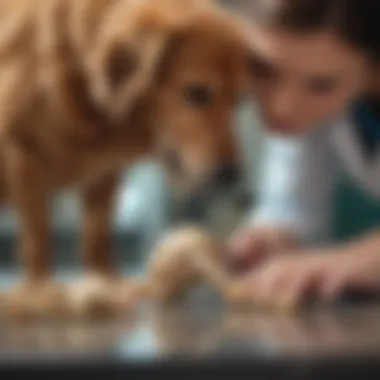Dogs and Chicken Bones: Health Risks and Alternatives


Intro
Dogs have been man’s best friend for centuries, forging bonds that transcend mere companionship. This relationship leads to myriad discussions around dietary choices, particularly when it comes to what they can safely consume. One area of significant concern is the consumption of chicken bones. Many dog owners might wonder whether letting their furry friends nibble on these leftover bones is a harmless treat or if it opens the door to potential health risks. This article ventures into various facets of this topic, including the anatomy of a dog's digestive system, the potential dangers posed by chicken bones, and alternative nutrition options that foster canine well-being.
Animal Overview
Common Name and Scientific Classification
Dogs, scientifically known as Canis lupus familiaris, belong to the family Canidae. With hundreds of breeds, each with unique traits and characteristics, they are among the most diverse domestic animals in existence.
Physical Characteristics
Dogs exhibit a wide array of physical traits. From the tiny Chihuahua to the enormous Great Dane, their sizes, shapes, and coat types can differ vastly. Generally, dogs possess strong jaws, sharp teeth, and a versatile digestive system designed for a varied diet – which humans often misinterpret when it comes to sharing leftover meals.
Habitat and Distribution
Historically, humans have domesticated dogs to fulfill various roles, including hunting, herding, and companionship. As a result, they are found in diverse environments—from bustling cities to serene rural areas. Dogs have adapted well to live alongside humans and can be found across the globe.
Understanding the Risks of Chicken Bone Ingestion
Physiological Considerations
An important aspect to acknowledge is how a dog's digestive system works. Dogs can handle certain foods that may not be suitable for other pets. However, when it comes to chicken bones, particularly cooked ones, the risks often outweigh potential benefits.
Common concerns include:
- Splintering: When cooked chicken bones break, they can splinter into sharp fragments capable of lacerating the esophagus, stomach, or intestines.
- Obstruction: Larger pieces may lead to blockages, resulting in serious health problems and possibly requiring surgical intervention.
A dog's internal anatomy is distinctly different from that of humans; their resilience often leads owners to overlook serious risks.
Alternative Nutritional Options
Instead of chicken bones, consider healthier alternatives that can satisfy a dog's chewing needs without the associated dangers. Options include:
- Raw bones: Uncooked larger bones can provide benefits, but they must be given under supervision.
- Dental chews: These are designed specifically for dogs to promote oral health while being safe.
- Fresh vegetables or fruits: Choices like carrots or apple slices can serve as tasty, nutritious treats.
Culmination
In summary, navigating the complexities of dog diets, particularly regarding chicken bones, commands more than casual inquiry. Recognizing the potential dangers and educating ourselves on safer dietary alternatives can make a significant difference in maintaining the health and happiness of our canine companions. Understanding these relationships not only benefits dogs but also enhances the bond between pets and their owners.
The Canine Digestive System
Understanding the canine digestive system is central to grasping how dietary choices, like the ingestion of chicken bones, can affect a dog’s health. Dogs, as carnivorous animals, have evolved to process food in a unique way. Their digestive system is designed for high-protein diets, but that does not mean it’s impervious to risks associated with certain foods. As we delve into this topic, we need to shed light on the specific anatomical features and digestive processes which play a crucial role in how dogs handle different types of food.
Basic Anatomy of a Dog's Digestive Tract
A dog’s digestive tract consists of various parts that work together to break down food and extract nutrients. It begins with the mouth, where teeth and saliva start the process of mechanical and chemical breakdown. Canines possess sharp teeth designed for tearing flesh, single molars for grinding, and a uniquely shaped tongue that helps guide food toward the throat.
From the mouth, food travels down the esophagus into the stomach. The canine stomach is a J-shaped organ, which holds food for several hours, allowing it to combine with strong digestive acids. Unlike humans, who have a more linear digestive process, dogs have a simpler stomach structure, which allows for quicker digestion, especially of protein-rich meals.
Once food exits the stomach, it enters the intestines, where most nutrients are absorbed. The small intestine is divided into three parts: the duodenum, jejunum, and ileum. Each section has different functions, with the duodenum being where most digestion occurs and the nutrients start to enter the bloodstream. In contrast, the large intestine mainly extracts water and prepares remaining waste for elimination.
"Understanding the anatomy of a dog's digestive system is vital for ensuring proper feeding habits and avoiding potential health risks associated with dietary choices."
How Dogs Process Food


Dogs are adept at processing foods that are high in fat and protein, which are the major components of their diet. When a dog consumes a meal, the process involves several phases. First is the ingestion phase, where the dog swallows food. The next phase is digestion, which involves both mechanical breakdown (chewing and stomach contractions) and chemical digestion (enzymes and stomach acids).
Once the food has been properly digested, the nutrients are absorbed primarily through the walls of the small intestine. This is where the food becomes energy and building blocks for the body. Dogs can store excess energy as fat, which is important for their health in times when food might not be readily available.
After nutrient absorption, what's left is passed into the large intestine, where water is reabsorbed and solid waste is formed. Dogs, unlike humans, don’t require a wide array of different foods. They thrive on a meat-based diet but do benefit from certain vegetables and grains. This evolutionary trait affects how they might react to non-meaty foods, like chicken bones, which can lead to complications if not handled carefully.
Nutritional Needs of Dogs
When we chat about our furry friends, understanding their nutritional needs is like hitting the nail on the head. Many pet owners might overlook these needs, but proper nutrition is crucial for a dog's overall health and wellbeing. Various factors, such as breed, age, and activity level, all play a significant role in deciding what a dog should eat. Just like humans, dogs have specific dietary needs that must be met to keep them happy, healthy, and full of life.
Moreover, with the rising trend of DIY dog food and home-cooked meals, it’s important for owners to have their heads in the game regarding balanced diets. Ensuring a dog gets the right nutrients can help prevent a slew of health issues down the line.
Macronutrients Essential for Dogs
Every dog has to juggle three main macronutrient types: proteins, fats, and carbohydrates. Let’s break it down:
- Proteins: Think of proteins as building blocks. They are key for growth, muscle development, and tissue repair. High-quality protein sources like chicken, beef, or fish are generally more beneficial than those containing lower-quality proteins.
- Fats: Not all fats are enemies! Healthy fats are vital for energy and can help with skin and coat health. Omega-3 and Omega-6 fatty acids, found in fish and certain plant oils, can work wonders in supporting your dog’s overall health.
- Carbohydrates: Carbs provide energy but should be given in moderation. Sources like sweet potatoes, rice, and certain vegetables can be included but must be balanced with proteins and fats.
The right balance of these macronutrients contributes not just to physical health but also affects mood and energy levels. Think about it: a dog who's well-fed in terms of nutrition is often a happy dog.
Importance of Bone in a Dog's Diet
When it comes to bones, the conversation gets a bit tricky. On one hand, bones can supply some vital nutrients, such as calcium and phosphorus, which support bone health. Dogs have been crunching on bones for eons, and it's part of their instinctual behavior. However, not all bones are created equal, especially those from chickens.
- Calcium and Phosphorus: These minerals found in bones are essential for healthy bones and teeth. They help in the formation of strong skeletal structures, assisting older dogs who may suffer from bone-related diseases.
- Natural Chewing Activity: Chewing on bones can keep a dog occupied and is crucial for mental stimulation.
It’s important to know that while some bone is beneficial, there are also significant risks involved. Dogs can easily splinter chicken bones, leading to choking hazards or possible damage to their digestive tract.
Takeaway: Balance is key. While bones can be part of a dog's diet, careful consideration is needed to avoid potential risks.
Understanding Chicken Bones
Understanding chicken bones is a crucial aspect of the discussion surrounding canine nutrition. It is not merely a matter of evaluating their dietary value, but it also ties into the overall health and safety of dogs. Many pet owners might think feeding their dogs bones is harmless or even beneficial, as dogs seem to enjoy the act of gnawing on them. However, not all bones are created equal. Knowing the different types of chicken bones and their nutritional profile is vital for anyone who wants to ensure their furry friends eat safely and healthily.
Types of Chicken Bones
When we consider chicken bones, we need to categorize them properly. Different types of bones exhibit unique characteristics that impact a dog’s health when ingested. There are generally three main types:
- Raw Chicken Bones
These are typically fed as part of a raw food diet. They are softer and easier to chew, which means they are less likely to splinter. Dogs can digest these bones more effectively, and they often provide essential nutrients. - Cooked Chicken Bones
These are commonly found in leftover food. Cooking bones makes them brittle and more prone to breaking into sharp pieces. This poses severe choking hazards and can cause injuries to the dog's digestive tract. - Weight-bearing Bones
Larger bones, like those from the chicken's legs, generally contain more marrow and nutrients but are also tougher. These can be hard for some dogs to chew and may be more dangerous as they can break into hazardous shards.
Each type plays a different role in a dog’s diet, thus understanding the implications of consuming each type is essential for avoiding potential health problems.
Nutritional Value of Chicken Bones
Now, let’s delve into the nutritional profile of chicken bones. Often overlooked, they serve multiple purposes in a dog’s diet:
- Calcium and Phosphorus: Bones are crucial sources of calcium and phosphorus, essential for maintaining strong bones and teeth.
- Minerals: Beyond calcium, they provide magnesium and potassium, important for a dog's overall well-being.
- Protein: When dogs consume raw bones, they also get protein from attached meat, which is vital for muscle health.
- Dental Health: Chewing on bones can help reduce plaque and tartar buildup, contributing to healthier teeth.
However, it’s essential to differentiate between raw and cooked offerings.
"While raw bones can be nutritious, the hazards associated with cooked bones are substantial and can't be ignored."
The balance lies in careful consideration of what type of bones are appropriate, especially when considering an individual dog's size, age, and health status. Always observe whether the dog reacts positively or negatively after being given a bone. If any unusual behavior occurs, promptly consult with a veterinarian.
Risks of Feeding Chicken Bones to Dogs


Feeding chicken bones to dogs is a topic that stirs considerable debate among pet owners. While some dog enthusiasts believe it can be beneficial due to calcium and protein intake, a clear understanding of the risks is crucial. This section dissects the potential dangers involved in letting your dog munch on chicken bones, helping dog owners make informed choices about their pets' diets and long-term health.
Choking Hazards Associated with Bones
One of the foremost dangers when it comes to feeding chicken bones to dogs is choking. When a dog gets their jaws around a bone, they may chew it into smaller pieces. However, these pieces can splinter sharply, creating larger fragments that pose a serious choking risk.
Just imagine it—a rambunctious dog chasing a fallen piece only to have it lodge firmly in their throat. This can be life-threatening. Some signs indicating a dog is choking include:
- Pawing at the mouth
- Gagging sounds
- Difficulty breathing or excessive drooling
It’s essential to remain vigilant and ensure that any chewing materials are safe and appropriately sized for your dog's breed and size. Remember, while bones might seem like a natural chew toy, in reality, they can easily turn into dangerous projectiles.
Digestive Complications Caused by Chicken Bones
Beyond the threat of choking, chicken bones can wreak havoc in a dog’s digestive system. When a dog consumes these bones, the splinters can irritate or puncture the digestive tract. This can lead to various complications, such as:
- Constipation: Bone fragments can cause blockages in the intestines, making it challenging for the dog to pass stool.
- Peritonitis: A more severe condition, this occurs when a hole created by splintered bone allows fecal matter to leak into the abdominal cavity. This complication needs immediate veterinary attention.
Interestingly, not all dogs experience the same reactions. Larger breeds might process bones more effectively, but that doesn't mean they are immune to digestive issues. On that note, it’s wise to consult with a veterinarian before incorporating any type of bone into a dog's diet.
"Not all bones are created equal, and neither are all dogs. Know your pet, their health, and what they can safely digest."
Potential for Bone Fractures
Perhaps an overlooked risk is that chicken bones, especially if they are cooked, can cause dental problems for dogs. As dogs gnaw on a bone, the hardness might lead to fractures in their teeth. This is particularly a concern for older dogs or those with existing dental issues.
Bone fractures can lead to:
- Pain and Inflammation: A fracture is often painful, leading to difficulty eating and even swelling around the jaw.
- Infections: Any damage to the gum line can lead to bacteria entering the bloodstream, potentially resulting in serious conditions down the line.
Vet checks are vital if there’s any suspicion of dental damage; avoid using chicken bones as a substitute for dental chews or toys. The risk simply outweighs any potential benefits chickens bones might offer. Instead, safer options exist to ensure your pet's dental health and overall well-being without the associated risks.
Identifying Signs of Distress in Dogs
Understanding the signs of distress in canines is not just important; it’s crucial for their well-being. Every dog, much like humans, can express discomfort or pain in diverse ways. These signs are often subtle and can easily be overlooked, especially by new dog owners. Recognizing these symptoms can make a world of difference in how quickly and effectively a problem is addressed. When it comes to feeding dogs chicken bones, the importance of being vigilant heightens, as the aftermath of such consumption might manifest through specific warning signs.
Common Symptoms of Digestive Issues
When a dog experiences digestive complications, symptoms can range from mild to severe. It's essential to be knowledgeable about the various indicators, as early detection could prevent more serious health problems down the line. Here are some common symptoms that might put you on alert:
- Vomiting: If your dog suddenly starts to vomit, especially if it happens several times, this could signal distress.
- Diarrhea: Loose stools or changes in bowel movements can be a clear indication that the digestive system is not handling its food well.
- Loss of Appetite: If your dog seems uninterested in their food, it’s usually a sign that something’s off.
- Lethargy: An unusually lazy pooch that’s not their normal bouncy self can indicate that they’re not feeling great.
- Abdominal Pain or Tenderness: If your dog whines when you touch their belly or appears to be guarding their abdomen, it’s a strong hint something isn’t right.
- Excessive Salivation: If you notice your dog drooling more than usual, particularly in conjunction with other symptoms, be alert.
Being proactive and observant can save your dog's life.
Understanding these signs can guide you on the necessary steps to take, which often involves a quick trip to the vet.
Understanding Dog Behavior After Eating Bones
The behavior of dogs post-meal can tell us much about their health and how they are reacting to what they've consumed. After eating chicken bones, a dog's behavior may change in ways that warrant attention. Here are a few behavioral cues you might see:
- Restlessness: Your dog might seem agitated or uncomfortable, struggling to find a comfortable position to lie down.
- Excessive Drinking: A sudden thirst can point to discomfort or even a potential blockage.
- Pacing or Whining: These actions could mean that your dog is feeling unwell or is in pain.
- Change in Bathroom Habits: If your dog is straining to defecate or showing signs of discomfort while doing so, it’s crucial to investigate further.
- Seeking Isolation: If a normally sociable dog starts withdrawing from the family, that can be a sign that they are experiencing pain.
Recognizing these signs not only benefits your dog but also equips you with the information needed to consult a veterinarian effectively. Understanding dog behavior and physical signs of distress is paramount, especially if chicken bones have been part of the equation. In short, your attention can play a key role in your dog’s recovery and health.
Nutrition Alternatives to Chicken Bones


When discussing canine nutrition, it's crucial to recognize that while chicken bones often attract dog owners for various reasons, there are more suitable alternatives that cater to both safety and health. Given the potential risks associated with feeding dogs chicken bones, such as choking and gastrointestinal blockages, exploring healthier options is a vital aspect of responsible pet ownership.
Safe Chew Options for Dogs
Choosing safe chew alternatives can not only prevent health hazards but can also contribute to your dog's overall dental health and well-being. Here are some noteworthy options:
- Raw Vegetables: Carrots and sweet potatoes serve as crunchy snack alternatives. They are low in calories and beneficial for your dog's teeth.
- Fruits: Apples (without seeds), blueberries, and bananas provide vitamins and fiber. Just be cautious with portions.
- Bully Sticks: These are natural protein-packed chews that dogs love. They promote dental health and are generally quite safe when produced by reputable brands.
- Dental Chews: Many companies produce specifically designed chews that not only satisfy a dog's urge to chew but also aid in cleaning the teeth and freshening breath.
- Antlers and Bones: Look for commercially available, safety-tested bones made specifically for dogs. These can keep your dog occupied without the risk of splintering like chicken bones.
Taking care to choose the right alternative can make all the difference in your dog's health. Always supervise your dog while they are chewing to prevent potential choking hazards.
Commercially Available Bone Products
If raw bones are not an option, you might consider various products that mimic the taste and texture of bones without the associated risks. These are designed with dogs' safety and nutritional needs in mind. Here are some examples:
- Kong Toys: Durable rubber toys that can be filled with treats, they also encourage chewing, which is great for dental health.
- Nylon Bones: These come in various flavors and are built to withstand aggressive chewing.
- Synthetic Bones: Often made from non-toxic materials, these bones satisfy chewing instincts without the splintering risks.
- Freeze-Dried Bones: They simulate the natural taste of real bones while being lighter and safer for dogs.
A factor to consider when choosing commercial options is the ingredient list. Avoid products loaded with preservatives or fillers. You want to ensure that whatever your four-legged friend munches on is as close to a natural diet as possible.
"Preventative care is far better than dealing with a crisis later. Ensuring our pets have the safest dietary options is paramount."
Preventing Accidental Ingestion
Preventing accidental ingestion of chicken bones is a crucial aspect of ensuring canine health and safety. Dogs are often curious creatures, eager to explore and taste the world around them. This inquisitiveness can sometimes lead them to dangerous situations, particularly when it comes to food. When dogs accidentally consume chicken bones, they could face a multitude of health hazards, from minor digestive issues to severe life-threatening conditions. As such, prioritizing prevention is not merely a good practice but an essential responsibility for dog owners.
Training Dogs to Avoid Dangerous Foods
Training your dog to avoid dangerous foods, including chicken bones, is an important skill that can save them from potential harm. Teaching basic commands like "leave it" or "drop it" can effectively reduce the risk of your dog snatching up harmful items. Here are some practical approaches to consider:
- Start with Basic Commands: Training commands such as "no" or "leave it" helps establish a framework for your dog to recognize what should be avoided.
- Practice Consistently: Repeat these commands often, and reinforce positive behavior with treats or praise. Consistent practice creates a strong association in their mind.
- Controlled Environment: Initially, manage their environment during training sessions. For example, practice outside in areas where food remnants are less likely to be found.
- Use Distractions: If your dog is particularly motivated by food, practice training with distractions, gradually increasing complexity as your dog learns.
"An ounce of prevention is worth a pound of cure." This holds true in the dog-owner relationship. Regular training sessions can prevent a world of trouble in the long run.
Through patient and consistent training, the goal is to instill awareness in your dog, reducing the chances of consuming chicken bones or any dangerous food items.
Safe Food Disposal Practices
Adopting safe food disposal practices plays a pivotal role in preventing accidental ingestion of chicken bones. It’s not just about keeping trash cans secure, but also about overall food safety in your home environment. Here are a few guidelines:
- Seal Food Waste: Always place food waste, especially bones, in sturdy, sealed bags before disposing of them to limit odors and accessibility.
- Invest in Dog-Proof Trash Cans: Consider using trash cans with secure lids that only people can open. This adds an extra layer of protection against curious noses.
- Composting Caution: If you compost, be cautious about what you include. Avoid chicken bones and other hazardous materials that could attract dogs.
- Educate Family Members: Ensure everyone in the household understands the importance of safe disposal practices. Children, in particular, should learn not to leave food unattended, as a dog will be inclined to snatch it up if given the opportunity.
- Outdoor Cleanliness: Keeping the yard tidy by removing fallen food, bones, or scraps from barbecues can avert any accidental ingestion by your furry friend.
By implementing these practices, you create a safer home environment for your dog, minimizing risks associated with accidental ingestion of chicken bones and other potentially harmful foods.
Emergency Response for Dogs that Ingest Chicken Bones
When it comes to the well-being of our canine companions, understanding how to respond in emergencies is crucial. Dogs are often curious and may not recognize the dangers associated with certain foods, particularly chicken bones. Hence, this section aims to shed light on the immediate actions and considerations pet owners should take if their dog ingests chicken bones, while also emphasizing the importance of seeking professional veterinary help afterward.
Immediate Actions to Take
If you catch your dog in the act of munching on chicken bones or discover several bones stashed away after they’ve finished, remain calm but act swiftly.
- Assess the Situation: Carefully check what type of bones your dog has eaten. Are they raw or cooked? Cooked bones can splinter and pose a higher risk of injury. Raw bones tend to be safer but can still cause issues.
- Do Not Induce Vomiting: Some pet owners may think that making their dog vomit is a good idea after ingestion. However, inducing vomiting can sometimes do more harm than good, especially if the bones have splintered and could cause additional damage during expulsion.
- Monitor Behavior: Watch your dog closely for any signs of distress. Is the dog whining, pacing, or refusing to eat? Any unusual behavior warrants a trip to the vet.
- Check for Obstruction: Keep an eye out for signs like excessive drooling, gagging, or difficulty breathing, which could indicate a blockage in the throat. If you notice any of these symptoms, it's important to seek veterinary help immediately.
- Stay Calm: Dogs can sense your emotions. If you appear panicked, your dog may become anxious, which can exacerbate their distress. A calm demeanor will help you facilitate a more effective response.
"An ounce of prevention is worth a pound of cure." This popular saying rings true when it comes to the health and safety of our furry friends.
Consulting a Veterinarian
Taking your dog to the veterinarian should be a priority if any alarming symptoms arise.
- Explain the Situation: Clearly communicate to the vet what your dog has eaten, how much, and when. Details matter when assessing the potential risks associated with chicken bone ingestion.
- Physical Examination: The veterinarian will conduct an examination to check for any signs of pain or blockage and may recommend imaging studies like X-rays to visualize any potential obstructions in the digestive tract.
- Treatment Options: According to the condition of your dog, treatments can range from monitoring at home to more intensive care such as surgery in the worst cases. The vet will determine the best course of action based on the initial assessment.
- Follow-up Care: If your dog shows no immediate signs of distress but has ingested bones, make sure to schedule a follow-up appointment. Some complications can arise hours or even days later, so vigilance is key.
After an incident of chicken bone ingestion, having this knowledge in your back pocket can be a lifesaver for your dog. Taking immediate action and knowing when to seek professional help can make all the difference in ensuring your canine companion remains safe and healthy.







